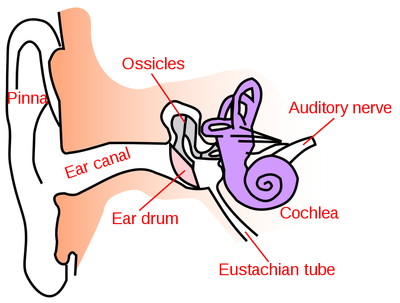Hearing
Contents
Key Stage 1
Meaning
Hearing is what we sense with our ears.
Key Stage 2
Meaning
Hearing is one of the 5 main human senses.
About Hearing
Key Stage 3
Meaning
Hearing is a sense that allows animals detect sound.
About Hearing
- Animals hear with their ears.
- Hearing can be damaged by listening to loud sounds too often.
- The ears of different animals can hear different sounds. Some animals can hear sounds too high pitched for us to hear and some can hear sounds too low pitched for us to hear.
There are several parts of the ear you should know:
- Pinna - The shaped cartilage collects the sound.
- Ear Canal - The tube leading to the ear drum.
- Ear Drum - This vibrates like a drum skin when sound hits it.
- Ossicles - Three tiny bones that pass the vibration to the cochlea.
- Cochlea - A spiral tube with a liquid inside it and tiny hairs attached to nerve cells.
- Eustachian Tube - A tube used to keep the pressure the same both sides of the ear drum to stop it bursting.
- Auditory Nerve - The nerve connecting the ear to the brain.
| A diagram of the ear. |
- Sound travels into the ear canal where it causes the ear drum to vibrate.
- The ear drums is connected to the ossicles which pass the vibration onto the cochlea.
- Tiny hairs in the cochlea are connected to nerves that make an electrical signal which goes to the brain.
Key Stage 4
Meaning
Hearing is a sense that allows animals detect sound.
About Hearing
- Animals hear with their ears.
- Hearing can be damaged by listening to loud sounds too often.
- The ears of different animals can hear different sounds. Some animals can hear sounds too high pitched for us to hear and some can hear sounds too low pitched for us to hear.
There are several parts of the ear you should know:
- Pinna - The shaped cartilage collects the sound.
- Ear Canal - The tube leading to the ear drum.
- Ear Drum - This vibrates like a drum skin when sound hits it.
- Ossicles - Three tiny bones that pass the vibration to the cochlea.
- Cochlea - A spiral tube with a liquid inside it and tiny hairs attached to nerve cells.
- Eustachian Tube - A tube used to keep the pressure the same both sides of the ear drum to stop it bursting.
- Auditory Nerve - The nerve connecting the ear to the brain.
| A diagram of the ear. |
- Sound travels into the ear canal where it causes the ear drum to vibrate.
- The ear drums is connected to the ossicles which pass the vibration onto the cochlea.
- Tiny hairs in the cochlea are connected to receptor cells in the ears which create an action potential which sends an impulse to the central nervous system (CNS).
